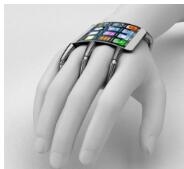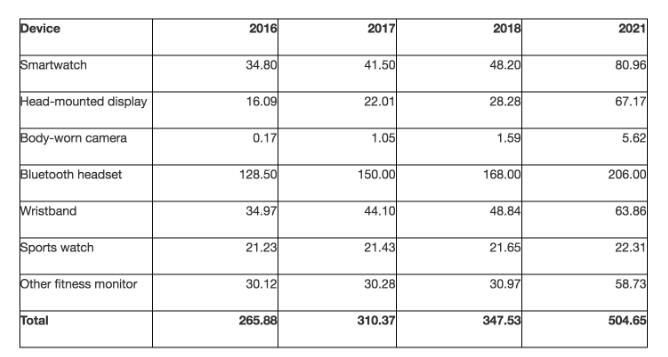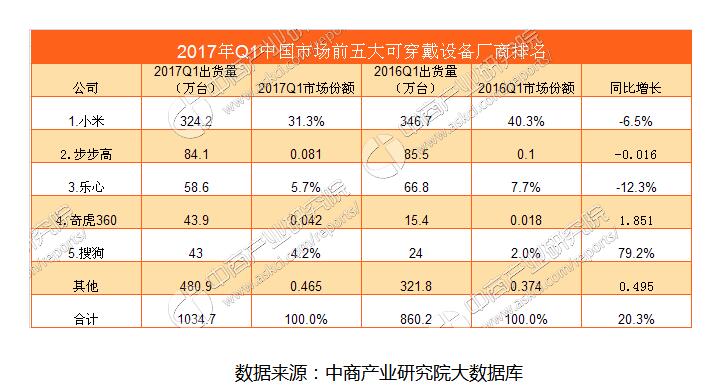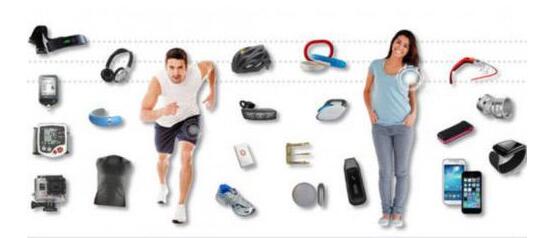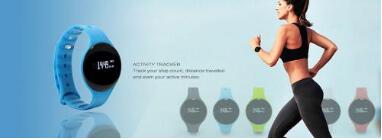According to data from several market research organizations, the wearable device market is picking up. Apple Insider reported that in the second quarter of 2017, wearables shipped 26.3 million units, up 10.3% year-on-year. Market research firm Gartner predicts that global wearables shipments will be 310 million units this year, up 16.7% from last year, and the market size will reach $30.5 billion. With the gradual popularization of consumption upgrades and technologies such as AI, VR, and AR, wearable devices have moved from a single function to a multi-function in the past, and are more portable and more practical. In the future, wearable smart devices will play an increasingly important role in biometrics, security and digital payments. At the same time, it will develop in a more diversified direction. Global wearables shipments in 2017 exceeded 300 million units Recently, Gartner released the global wearable device market report, which is expected to increase global wearable device shipments by 16.7% in 2017, including various types of products, from smart watches and wearable cameras to head-mounted displays. equipment. This year, the total sales of wearable devices worldwide will reach 3.104 million units, and the global total revenue will be 30.5 billion US dollars, of which 9.3 billion US dollars will come from smart watch products represented by Apple AppleWatch and Samsung Gear. It is worth noting that according to Gartner's prediction, children's smart watches will become the most obvious type of growth in the future, and will reach 30% of the overall shipment in 2021. Children's smart watches are mainly aimed at children between the ages of 2 and 13 years, and parents of these children do not want their children to have smart phones, so smart watches have become a good substitute. At the same time, by 2021, traditional types of fashion or luxury smart watches will account for 25%, and these products will rely mainly on brands to attract young consumers. Children's watches shipped more than 3.5 million units in the first quarter of 2017 According to relevant data, China's wearable device market shipments in the first quarter of 2017 were 10.35 million units, of which China's children's watch shipments reached 3.51 million units, a year-on-year increase of 64.9%. As one of the hot-selling smart wearable devices, 360 children's watches increased their sales in the first quarter of 2017 by 185% year-on-year, and they became the industry benchmark by winning the sales champion in large-scale online events. Wearable device market picks up Recently, a number of market research organizations and media released the latest global quarterly wearable device tracking report. According to the report, the market for wearable smart devices is picking up. Apple Insider reported that in the second quarter of 2017, wearables shipped 26.3 million units, up 10.3% year-on-year. Field research firm Gartner therefore predicts that global wearables shipments will be 310 million units this year, up 16.7% from last year, and the market size will reach $30.5 billion. In the latest tracking report, market research firm IDC found that in the past quarter, shipments of entry-level wearables (not supporting third-party applications such as fitness bracelets) were found to decline for the first time, down 0.9%. Shipments of smart watches such as Apple Watch and Android Wear increased by 60.9%. The latest report released by American research firm TracTIca also pointed out that fitness trackers and smart watches are still the "flagmen" of the wearable market. Gartner also believes that smart watches are the most growing of all wearable devices. According to Gartner's forecast, global smartwatch shipments this year will account for 13.3% and $9.3 billion in revenue from wearables. In 2021, sales of smart watches reached nearly 81 million units, accounting for 16% of wearable devices sales, and revenues increased to $17.4 billion. In addition, Gartner predicts that children's watches will rise, accounting for 30% of the total shipments of smart watches in 2021, and traditional watch brands will account for 25% of overall shipments. Smart wearable products are moving towards diversification According to Jitesh Ubrani, senior research analyst at IDC Mobile Device Tracking Inc., the decline in shipments of wearable devices for the above-mentioned single-function declines, the wearable device is transitioning from a single-function phase to a smarter, more feature-rich Stage. Consumers are entering an era of more sophisticated devices. Previously, single-function wearable devices such as GPS and fitness trackers have become the main functions of modern smart watches. In addition to more features, today's smart wearables are also more portable and more usable. At present, the main functions of wearable devices are communication, health, sports, entertainment, positioning, payment, artificial intelligence interface and so on. Take health functions as an example. For example, a small bracelet can monitor the body's various health indexes such as blood sugar and blood oxygen. It can also manage chronic health conditions and prevent chronic diseases such as diabetes and heart problems. . Fitbit recently launched the new smart watch Fitbit Ionic, which features health features. Equipped with an enhanced heart rate monitor, including a blood oxygen saturation (SpO2) sensor that tracks the oxygen content of the blood. In the future, this technology could be extended to monitor other health conditions, such as sleep apnea. In addition, Fitbit Ionic also has a built-in “fitness coach†that guides the user to move correctly. At the same time, Samsung also launched three wearable devices in one breath, namely the Samsung Gear Sport smart watch; Gear Fit 2 Pro fitness bracelet and IconX 2018 wireless Bluetooth headset, designed to challenge Apple and Fitbit in the health field. In the short term, in addition to continuous improvement around health and fitness functions, wearable smart devices will play an increasingly important role in biometrics, security and digital payments. In the future, with the development of consumption and technology, the wearable market will develop in a more diversified direction. TracTIca predicts that smart watches will become the largest wearable device category, followed by fitness trackers and body sensors. Other devices will also play a catalytic role in market growth, including smart clothing, wearable cameras and smart glasses. Consumption and technology upgrades have spawned a huge market blue ocean Some experts believe that the current development of wearable devices has been from the first phase of the basic sports and physical data collection and processing, to the second phase of health and living environment parameters. In the third phase of the future, with the gradual popularization of technologies such as AI, VR, and AR, wearable devices will become a key link in artificial intelligence. For the future development trend of wearable devices, the industry said that wearable is promoted by sports health. In all wearables, wristband smart hats, etc., an indispensable function is health, life, this It is also the driving force for industry growth. The data shows that in the United States, more than 80% of consumers believe that one of the important functions of wearable technology is to make health care more convenient, 71% of Americans believe that wearable technology can help them "improve health and fitness." As the majority of users are further educated, as well as the development of biosensing, network communication and other technologies, it is believed that wearable devices will cover more and more ordinary users and become an indispensable part of people's lives in the future. Some market research organizations predict that annual wearable device shipments will increase from 118 million units in 2016 to 430 million units in 2022, with a compound annual growth rate of 24.1%. Product innovation is especially important Despite the current boom in the smart wear market, it still does not cover up the shackles of its products. On the one hand, the current smart wearable devices are designed to be difficult to have a bright feeling. Smart wear is different from smart phones, and the demand for its stylish look is especially important. Industrial design is the core. At present, the smart wearable devices on the market mostly follow the assimilation phenomenon and lack the design culture concept of the product itself. It is so difficult to be at the heart of the public's first contact with the product. On the other hand, the wearable smart device function is easy to go into a misunderstanding, that is, constantly superimposing various functions, resulting in bloated device function. It is not difficult to find that although there are many smart wearable devices on the market, there is no product that can successfully enter thousands of households, including Apple Watches, because the product maturity is not enough, and second, because the product value is far from satisfying consumers. demand. In order to gain market recognition, manufacturers of all sizes still have a long way to go. It can be seen that for entrepreneurs and giants entering the field of wearable devices, in order to open up a broader market, the perfect integration of design and technology should be taken as the starting point, through the reform and innovation of products, blurring the boundaries between fashion and technology. Let technology integrate into products naturally, so that consumers can enhance their technological experience while pursuing fashion. Information security risks cannot be ignored Analysis, there are several main reasons for information security risks: First, the existing technology constraints and software and hardware itself have security vulnerabilities, which provides a natural breeding ground for hackers, fishing, ransomware, etc. Second, people The awareness of security protection in smart wearable devices is relatively low, and it is impossible to accurately and effectively deal with the risk of personal information leakage. Moreover, equipment manufacturers may invest too little in information security research and development on smart devices due to funding problems or cost considerations. Fast and effective security response mechanism; Finally, national quality and safety testing has many gaps in the detection standards of intelligent hardware, and the ability of macro-management information security is limited. Therefore, in order to improve the information security level in the field of smart wearable devices, equipment manufacturers are required to pay attention to product safety research and development, and ensure safety from the source; relevant national departments should formulate relevant standards to regulate the scope and behavior of the collection and use of personal information; Applicants should increase their personal safety awareness and be cautious when dealing with personal privacy, property, and personal safety. With such a combination of various parties, a multi-pronged approach can create a healthy application environment for smart wearable devices and create further possibilities for opening up the market. 2.1 Home Theater Speaker,2.1 Speaker System Home Theater,Surround Sound Speakers,2.1 Home Theater GUANGZHOU SOWANGNY ELECTRONIC CO.,LTD , https://www.jerry-power.com